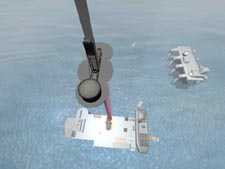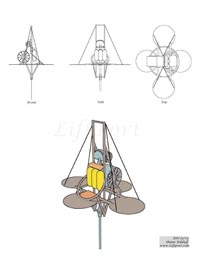Home > Interviews > The Space Elevator - An Interview with LiftPort's Michael J. Laine
The Space Elevator - An Interview with LiftPort's Michael J. Laine
The Space Elevator"And yes: People will be able to ride in it."
Michael J. Laine Click to see full photograph of Laine taken at the Air Force Academy on Sep. 30, 2004. On the left you will see Major Tom Joslyn, and on the right is Cadet Dan CaJacob. Laine is in the middle, holding the robotic Lifter that they call "Squeak." |
|
NN: What would the SE be used for? Off-world migration, space-tourism, asteroid mining, launching packages (such as satellites)? How does it benefit each?
As the SE develops, these are the things it will affect first.
In order:
- Communication Satellites
- Solar Energy Satellites
- Expanded Space Stations for
- Communications
- Repair facilities for sats
- Pharmacuedicals and biosciences
- Moon/Mars/Asteroid Exploratory Missions
- Settlement Missions
All of these will be within the first 5 years of completion and standard cargo delivery. Once that basic infrastructure is in place, we have expanded into a dedicated 'up' and a dedicated 'down' ribbon of 5 tons of cargo, 200 trips a years. Then we do the same thing and build up a 20 ton up/down system. Once that full system is in place, things get really 'fun.' Price per pound drops like a brick, because we have so much spare capacity. That's when the tourism, mass migration/colonization, asteroid mining, medical labs/burn units/convalescent centers open up. Personally, I am looking forward to hosting the Olympics up there.
NN: What advantages does having a SE bring to the country or business that builds the first one?
It means limitless, safe, simple, affordable access to space, with a predictable cargo schedule. It means the cargo can become an enormous increase in energy resources (huge solar energy satellites supplying clean - endlessly renewable - power back to earth); expanded, permanent settlements on the moon and mars and asteroids, and a stepping stone beyond, into the 'wild black yonder.' It means expanded communications to everyone on the planet - phone, video, internet, because of a greatly increased commsat infrastructure. It means bio-science advances that may allow us to live longer and in greater comfort in our old age, and better, higher purity medicines that we will use in our goal of a full and healthy life. So these advantages would go to the whole planet, really.
The company that maintained the system would probably be very profitable as well.
LiftPort Group intends to be the company that leads the international consortium in the construction and operations/management of the first Space Elevator. Once the first one is established, I believe many more will be built, because it is the only space transportation infrastructure that can apply economies of scale. They actually get less expensive the more you build, which also means the price/kilo can fall dramatically, as expanded systems are built.
There are significant commercial barriers to entry for whomever tries to build the 2nd one, if they try to do it without the cooperation of the people who built the first one.
LiftPort Concept Anchor

Large Version |
NN: What budget do you believe is necessary to make it happen within 10 years?
Well, we've never said it was possible in 10 years. We have consistently stated 15 years (from when we started last year). So, take a look at our countdown clock on our website - we have about 14 years to go.
It will take about $7-10B. The brief outline of expenditures looks something like this:
- 2018 system complete - $1B
- 2015 system deployment - $2B
- 2009 design and fabrication of components - $5B
- 2004 financing, research/development, social/political/legal support - $2B
And it's important to notice that we only spend 20% of the budget in the first 1/3rd of the time. It's during that crucial period that we test and expand our knowledge and determine if we can or cannot actually accomplish our goal. If not, then the money spent will still have huge commercial spinoff value, (which will more than pay back its investment) and if we can build it, all the better, the risk has gone way down, based on our newly acquired science.
Using a laser beam to boost the climbers into space is doable, said Harold Bennett, president of Bennett Optical Research, Inc. of Ridgecrest, California. "If you do it right, you can take out 96 percent of the effect of the atmosphere on the laser beam through adaptive optics," he said. The strength of the pulsed laser beam is less than the intensity of the Sun, so birds, airplanes, or human eyes wouldn't be affected, he said.
|
NN: Most people who have read about the SE know that producing substantial lengths of carbon nanotube ribbon remains one of the greatest hurdles. Has any recent science given hope that this hurdle will be overcome?
Did you see the work that was released recently from Los Alamos National Labs (link)? That ribbon isn't as far away as most people think.
NN: In your opinion, if a full-scale effort was launched today, how long before the first SE could be built?
Look at our countdown clock. we are serious about it. Lots of big projects, space, factories, tunnels, bridges say something like "in 20 years we'll..." and that gives them a lot of room to fudge the numbers and let deadlines slip. We don't want to be that kind of project.
We've set a date, and that is what we are working toward.
Many people have laughed at us about this. That's fine, my team knows how many days are left and our internal motto is 'Every Day Is Precious.' We know people are counting on us to make this happen, and we don't intend to let them down.
Ocean Platform

The ocean platform, as seen from the lifter as it crawls up a ribbon.
|
NN: Who's for it, and why?
The day we open for business, we will have 10x the current global launch capacity... that means that basic supply and demand forces will apply, and the cost per pound will drop dramatically. We are anticipating $400/lb ranges, and some people are predicting it could go lower than that, once the 2nd and 3rd elevators are built.
So, who will it benefit? Anyone that wants low-cost, high-volume access to space. This would mean, for instance, that smaller schools could do space-based research. Instead of a huge budget allocation, smaller schools could open up new branches of research, because the costs of access have dropped so much. What this means is that we could see significant advances in biosciences, pharmaceuticals, electronics and material sciences. Also, developing nations would benefit in the same way. Countries that didn't have any realistic ability to access space could launch satellites that would help monitor weather and natural resources management systems. Of course, let's not forget that this opens the way to Mars and the Moon in a meaningful way. Colonization becomes possible, so too, is the collection of solar energy from space and bringing that power back down to earth. Add to that the massive expansion of telecommunications systems - so if YOU want lower energy prices, from a clean, renewable source, if YOU want truly global telephone/internet access, and if you want the ability to dream of opening up a new frontier, the the SE affects YOU directly.
Let's not forget that the SE could be used for fun, tourism and hotels, and as you can probably imagine, some pretty 'extreme sports.' People are even talking about developing an 'Olympics' type event in space.
Cost of putting one pound of anything into space now - $10,000 ($22,000 per kg)
|
Of course, I don't want this response to be perceived as 'spin-control' of the project. There are some defense applications as well, which I am not going to go into details on, but it exists and needs to be recognized. I want to be clear, though, that we are not building a weapon, we are building a tool for future generations of the earth.
In the short-term, within 5 years after commercial completion, I am skeptical about asteroid mining, as I understand it now. As the SE evolves into multiple heavy-duty systems, that may change. But that is not being factored into my re-payment schedule for financing this project.
Lifter in Clouds

Lifters: Robotic cargo and construction cars.
|
NN: Who's against it, and why?
So far as I know, no one is 'against it.' Some people have said that this will be the 'death of the rocket industry' and I strongly disagree. I think there will be a huge boost in that field. Never forget that we are a 'point A to point B' transportation system. If you want to get to point C (and many of the really great things you can do in space will require that) the only way to get there is with rockets. So, with the completion of the SE, there will be a huge increase in the demand for small, efficient rockets. Also, who better than the rocket builders to build the large, industrial sized facilities - manufacturing, hospitals/retirement/rehabilitation centers, hotels for tourism, off-world exploration, and large solar arrays.
While some people warn us that the Boeings and Lockheed Martins of the world will want to squash the concept, we feel that they might be essential long-term partners, and that they will help nurture the growth of the space-based economy.
NN: What technologies do we need to develop to make it happen?
Tether
This might be much closer, thanks to Dr. Zhu's work at LANL. Still, it's hard to go from 4cm to 100000km.... but what his (and many other researchers) work is proving, is that we have a good set of theories and that by following them, significant progress is being made on a weekly basis. So, yes, it will be hard, but also, we are making progress - fast.
Propulsion (power) Electric vs. Chemical
This is not as hard as many of the other issues. Making a big power beaming system is very challenging, but the rockets we will need are well understood and commercial off the shelf technologies. The power beaming is an issue, as it requires advances in both lasers and thin-film, high-efficiency solar panel technologies. What I find interesting is that economically, our project becomes a driver for all these advances, and then once we achieve the new tech-levels, that becomes useful to industry in the 'down to earth' marketplace. There are lots of uses for these technologies, such as homes covered with inexpensive, easy to apply solar panels, that are capturing clean, renewable energy.
Space Junk and Asteroid Avoidance
This will be hard as there are a lot of debris up there. We will be hit by the 'little' pieces (which is part of the reason for a ribbon design and not a cable - its better able to take the hits). The 'big pieces are a problem. To avoid this, we are going to have to have and active radar system that is very sensitive.
Laboratories throughout the world are rapidly gaining atomically precise control over matter. As this control extends to an ever wider variety of materials, processes and devices, opportunities for applications relevant to NASA's missions will be created. This document surveys a number of future molecular nanotechnology capabilities of aerospace interest. Computer applications, launch vehicle improvements, and active materials appear to be of particular interest. We also list a number of applications for each of NASA's enterprises. If advanced molecular nanotechnology can be developed, almost all of NASA's endeavors will be radically improved. In particular, a sufficiently advanced molecular nanotechnology can arguably bring large scale space colonization within our grasp.
|
Weather: Lightening and Hurricanes Avoidance
While this comes up a lot as a 'big' problem, really it doesn't look like it's going to be. Sure, there will be lots of testing to validate our theory, but so far, this looks like a non-issue. Just place the system in a proven location that is benign, and then make it mobile by using a ship (the Liftport) as the earthly connector. By placing it on the equator, we negate all the big storms, because as they get closer to the equator, they loose all their force and fail.
Terrorists Threats
Our number one question is "what if a plane flies into it?" and I think that question stems more from the fear in the American psyche than it does as an actual scientific question. We are hundreds of miles from air/sea routes. We will have outstanding radar ability to detect incoming threats. And we have solutions to counter them.
On the other hand, this is not a good target for terrorist. Think about the term - terror means it has to have a humanistic target. Damaging the ribbon is a minor economic event, not even worth the effort of these groups. The Superbowl is a much more 'juicy' target. If they break the ribbon, we loose a few weeks of cargo transport, we repair it, and get back to work. Of course we have done our homework regarding disaster recovery, just in case.
Thermal Flux
It's where there is a different thermal expansion/contraction rate of materials between the CNT and the matrix that surrounds the CNT. It's a pretty big issue because as the ribbon moves into and out of the sunlight, it's going to heat/cool at an astounding rate. This will fatigue the ribbon; the problem is, we can't even begin to model this, until we have a better understanding of the ribbon/composite itself.
So this problems waits for a while, and then we tackle it.
Of course there are other issues - LPG lumps them into 4 super-categories:
- Science/Technology
- Political/Societal
- Legal
- Finance/Commercialization
Dr. Brad Edwards has been primarily focused on the science/tech, and LPG has been working on the other three. Of course you could have all the problems in 3 of the 4 solved, and still not be able to build this thing. In this case, it's an 'all or nothing' concept. All the parts have to work, in order to build and operate the SE. What's important to point out, though, is that it is like this for EVERY construction project - bridges, tunnels, a new city hall, an industrial factory. All of these have to solve the same basic sets of problems. The difference of course is that the bigger the project, the more issues there are to sort out.
This is a big project, so it is correspondingly complex.
Lifter Ascending

The Earth, as seen from the lifter.
|
NN: Why isn't the U.S. government building one?
NASA Institute of Advanced Concepts was the original funders of the ground-breaking research. Through Marshal Space Flight Center, Los Alamos National Labs and many universities - the US government IS funding continued exploration of the idea. The most recent is the US Air Force Academy - they have signed on as a research partner, to continue the examination of critical systems. The University of Texas has also decided to lend a hand by getting their MBA program involved with evaluating our commercial model and advancing the business of building and operating the SE.
The fact is that I don't believe the US government will - or even should - build this. It will be built by a for-profit company that sees a large return on investment, in the future, for the risk they are taking now. LiftPort Group has a business model that will help make this possible; we are modeling this effort on the early transcontinental railroads.
They were privately financed, counted on governmental contracts for transporting mail to help ensure the repayment of the bonds that were issued. We intend to secure similar contracts from the US and other nations for low-cost, reliable, safe and consistent scheduling of cargo to space.
LPG is constantly looking to add to its research partner list, and to expand that list overseas and get other nations involved.
NN: What is International Public Inclusion (IPI)?
International Public Inclusion is exactly what it sounds like: an invitation to every human being to participate in the development of the Space Elevator in some manner. The Space Elevator is a tremendous project that will have an impact on the entire planet, not just the United States. While the project will be led by our US company, LiftPort Group feels humanity as a whole has a right to be involved in such a project. In order to provide as much benefit as possible from the Space Elevator, LiftPort Group would like to see many individual, academic, governmental, non-governmental, and corporate entities get involved.
LiftPort Group is dedicated to providing a venue to facilitate its policy of IPI via the LiftPort Group website (www.liftport.com). By offering such a forum, certain technical, legal, business, and philosophical challenges may be addressed before they become problems. LiftPort Group will create an international public dialogue through our online interactions and will also begin compiling information and archives detailing the development of the Space Elevator.
Cross views of the Counterweight

Rather than a captured asteroid as a counterweight, the Space Elevator will use it's own left-over construction equipment.
|
|
Michael J. Laine is the President and Chief Strategic Officer of the LiftPort Group "The Space Elevator Companies."
|
|
|
||
|
|
||
| The latest news from around the world, FREE | ||
|
|
||
|
|
||
| Premium Products | ||
|
|
||
|
Only the news you want to read!
Learn More |
||
|
|
||
|
Full-service, expert consulting
Learn More |
||
|
|
||
